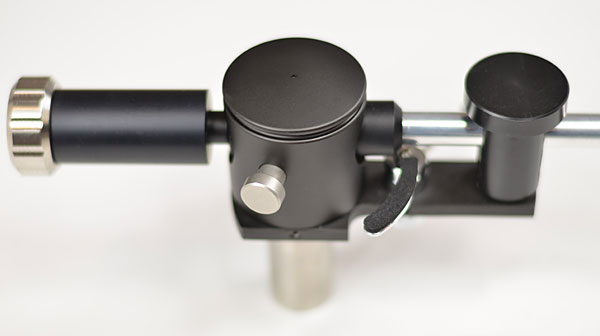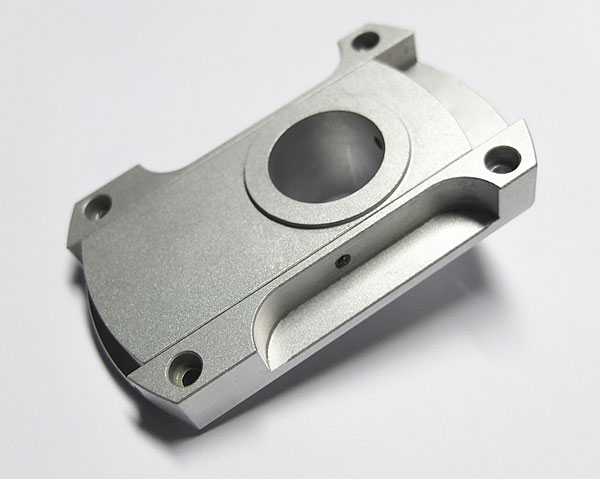| Columns Retired Columns & Blogs |
... an SME M2-12R or a Jelco SA-750L?
Curious to hear what else the GrooveMaster could do, I replaced the SPU with my Denon DL-103 cartridge, pressing into service the sort of plain-Jane headshell that these days comes standard with a great many commercial tonearms: an aluminum rectangle fitted with the nearly universal SME-standard connector, and measuring just a hair over 2" long from the flange on its connector to its forward edge. In other words, were the user to install a cartridge so that its stylus tip lined up with this headshell's forward edge, the distance from stylus to collet flange would be in the neighborhood of 52mm—which is, as I've blithered in this space ad nauseam, the dimension exhibited by virtually all type-G SPUs and similar pickup heads.
Easy overhang settings notwithstanding, I got into a bit of trouble. First, the counterweight arrangement described above, which worked with the SPU, was too much for the lightweight Denon and its lightweight headshell. I had to take it apart and play around until I discovered the right combination: the main steel counterweight alone. But even then, with the Denon's preferred 2.5gm downforce dialed in nicely, I noted that, with the stylus resting on a record, the headshell wasn't parallel to the disc's surface: its ass end was elevated, as people in engineering circles are wont to say, and considerably so.

Falling in titanium's favor
I listened to this combination before I looked closely at the headshell alignment, and heard evidence of its elevated ass-endedness: glare and edginess in the treble. Just as troubling was excessive bass overhang, heard in the timpani and lower-pitched strings. I attributed the latter to the Denon's low mass compared to the Ortofon SPU, and assumed it was thus a less perfect mate for the high-mass GrooveMaster II.
Then I remembered: the Audio MusiKraft Denon DL-103, which I wrote about in my August 2017 column—a denuded Denon DL-103 encased in a custom-machined metal shell—weighs about 3gm more than a standard Denon DL-103. In the spirit of the Everything Makes A Difference rules currently in place in the universe, I wondered if swapping out the standard Denon for the MusiKraft might tighten the wobbly bass. Better still, when I went to install my lingering review sample of the MusiKraft, I saw that its height—the distance from its mounting plate to its stylus—is at least a couple of millimeters greater than that of the stock version. Would that be enough to level out the headshell, and thus the armtube, as they played records?
As it turned out, yes: With the Audio MusiKraft Denon in place of the stock Denon, the headshell was now almost parallel with the record's surface, the front end of the headshell now only a hair too low. Of course, to get there I had to once again disassemble the counterweight assembly and revert to using an auxiliary weight to offset the more massive cartridge. But that was more than made up for when I heard that the glare had vanished.
As for the Denon's lack of bass tightness relative to the SPU, the MusiKraft was better in that regard than the stock DL-103—but only slightly. I began to regard the Dutch arm as more suited to SPUs, and reverted to the Ortofon. In the days and evenings that followed, I heard the combination sing on a great many albums. On a recent 45rpm reissue of the Grateful Dead's American Beauty (Warner Bros./Mobile Fidelity Sound Lab MFSL 2-429), the GrooveMaster's clarity and apparent lack of coloration helped me not merely enjoy but appreciate anew the beautiful and often unexpected vocal harmony lines in "Attics of My Life." The GrooveMaster–SPU #1S combination allowed a good sense of kick in "Don't Be Denied" and "Last Dance," from Neil Young's Time Fades Away (Reprise MS 2151). And the arm's lack of tizziness was very welcome with the Go-Betweens' 16 Lovers Lane (Capitol C1-91230), a fun and often deeply moving record, the brightish sound of which can be made tolerable with well-chosen playback gear.
Only one thing remained to be done: I needed to determine what, if any, advantages might be conferred by the GrooveMaster II's optional titanium armtube, which Audio-Creative suggests is of even higher mass than the stock aluminum tube (they don't specify the titanium tube's weight). As you might expect from the above, the swapover was a breeze, the only hurdle being, again, the counterweight struggles.
During those struggles, I did something stupid-smart (I assume there's a polysyllabic German word for that): While the stock, aluminum-tubed GrooveMaster was set to the SPU's 4gm downforce, I took my metal ruler and measured the distance between the counterweight and the arm's bearing housing; I then used the same ruler to reproduce that distance on the titanium-tubed GrooveMaster II, assuming it would get me close to 4gm without a lot of dicking around. But when I used my stylus-pressure gauge to confirm that I had it more or less right, it turned out I was way off: The downforce was way too high, and to get the same, correct downforce I had to move the counterweight much farther away from the bearings. So, yeah—apparently, the titanium armtube really is more massive.

I replayed the Go-Betweens album, and heard differences that all fell in the heavier armtube's favor. In the last track, "Dive for Your Memory," the entry of a very gently strummed, arpeggiated guitar chord—it's easy to miss—was much more audible, and it was more apparent that the guitar was an electric, not just a second acoustic. And when, in the second verse, bassist John Willsteed and drummer Lindy Morrison enter, both of their contributions were more dramatic, the bass sounding deeper and just plain louder, the drums more forceful.
But there was something else: Almost every element in that song—in particular, the sound of every note played on every instrument—was less mushy, though I hadn't thought they were mushy with the stock arm. Now I heard something more like the real sounds, with, especially, clearer, firmer note attacks. The sound was less artificial and more listenable, qualities that endured with every record I played from that point forward.
Of course, none of that means that the titanium armtube is superior per se—but it does suggest that the higher-mass arm is an even better mate for the low-compliance SPU pickup. Not that that comes as a big surprise or anything.
A final observation—and a necessary one, in the wake of my severest criticism of the Swissonor TA10: Both GrooveMaster IIs exhibited low apparent bearing friction. Still, getting these arms to "float" with the downforce set to zero was a chore—they wanted to go up or down, but not remain parallel to the platter. The EMT 997, that other banana-shaped arm, has a lateral outrigger weight in addition to its traditional counterweight; does that aid the EMT in maintaining a static balance, and is the absence of such a thing in the GrooveMaster the reason it's comparatively difficult to balance? I don't know.
Who needs anything more? I mused, a thousand words ago. Such words sometimes come back to bite. As it happens, both versions of the Audio-Creative GrooveMaster II are easy-to-use, good-sounding products, and both offer very high value for the money. Enthusiastically recommended.

... an SME M2-12R or a Jelco SA-750L?

I loved the Sumiko MMT which is actually a Jelco.
This reviewed Arm looks like it has more adjustability and a far higher price, phew farrrrrrrrrrrrrr higher.
Having Records, as a hobby, is getting super expensive, especially considering that Chad Kassem's stuff is released digitally.
Tony in Michigan

Art,
I liked the GrooveMaster report. I have ordered one, even though I have a couple of Schicks.
In the same vein, you might consider a report on the Border Patrol DAC SE. Its a DAC that brings digital closer to vinyl. My wife who typically says "they all sound good", when hearing it said "that sounds like vinyl".

Art,
Has anything supplanted your EMT arm as "the" tonearm for the TD-124? I'm thinking of getting another TD-124, this time a full Schopper restoration. I'm torn between an EMT and the TA10, or does the Groovemaster offer just as much for considerably less?
Thank you!

Wonder how the GrooveMaster II would work with a Kleos and AT33Sa? Building a new plinth for my DP-80 TT and looks to be a worthy competitor to the SME M2-12R.